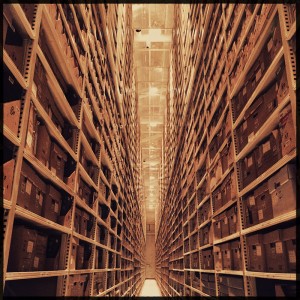
Like so many leather skirts, go-go boots and seersucker jackets that need to be carefully stowed in the interim between their respective periods in vogue, these great buildings of books, too, need to occasionally clear space for more useful, timely purposes.
To that end, the Libraries have thus far accommodated a need for additional “closet space” through the construction of off-site warehouses much reminiscent of the one imagined in the closing scene of Raiders of the Lost Ark, seemingly endless rows of shelving stretched from concrete floor to stories-tall rafter, where once-prized tomes and formerly-current periodicals can reside until such time as they are once again called upon to provide the critical information needed to complete some important research or solve some lingering question.
These library storage facilities (LSFs) house those low-circulation items and fragile materials that might be considered complementary resources for collections from across the campus of The University of Texas at Austin and beyond. Both the Harry Ransom Center and the Briscoe Center for American History are reliant upon this remote storage in order to free up room for the more high-value, high-use items in their ever-growing collections of cultural artifacts. Likewise, as parts of the Libraries’ valuable print collection are accessed less frequently than in the past, it’s logical to move those volumes into a high-quality storage environment and establish systems for retrieving books as scholars request them from storage. The migration creates space that can be repurposed for student use and newer technologies to facilitate a more productive, modern learning environment.
The Libraries also enjoined sibling rivals at College Station in two of the ventures thus far — the second of two facilities at the Pickle Research campus in North Austin, and a joint library facility (JLF) at Texas A&M’s Riverside campus outside of Bryan, Texas. In a collaboration that seeks to minimize the physical presence of materials while still availing the needs of institutions across the state, UT and A&M have pared some of their collections to a single-copy that is then shared cross-organizationally through a delivery system coordinated by the principals. The Austin unit constructed in 2010 is already at capacity, and the Riverside unit, which opened in 2013, has incorporated nearly half a million volumes to date. Given the successful outcomes of the partnership, there are already considerations for the development of further partnerships.
Beyond the space-saving functionality of the LSFs, there is a compelling financial reason for moving low-use items off-site. A 2010 study showed the cost of storing a single volume in an open library stacks facility is $4.26 per year, taking into account personnel, lighting, maintenance and heating and cooling costs. The cost is pegged at 86 cents per volume for storage at a facility such as the Riverside unit jointly operated by the Texas A&M and University of Texas Systems — representing a savings of $3.40 per volume.
The Libraries learned recently that it had received approval from the Board of Regents to begin construction on a third unit at the Pickle campus, which is necessitated by the Dell Medical School’s future plans to build where the Collections Deposit Library currently stands. CDL has long served as a storage facility on campus for permanent collections, as well as a holding space for unprocessed materials, but due to its age and lack of available space, the building has just about outlived its utility. The new construction at the north Austin campus will allow significant additional materials from other campus locations, as well.
The coming facility will, like its predecessors, be climate controlled, and will hold roughly one million additional volumes, bringing the Libraries over halfway to completing a stated goal of removing two million books from campus locations to off-site storage. Construction on the $8 million building will begin in 2016 and is expected to open in late summer of 2017.
